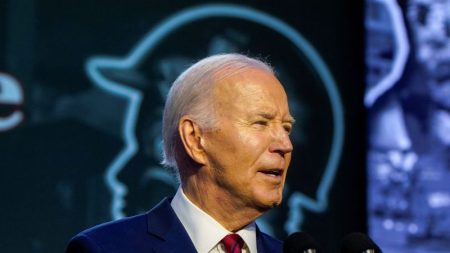The Biden administration has finalized a rule that requires individuals who sell firearms online or at gun shows to conduct background checks on potential buyers, aiming to close the “gun show loophole” that allows some sales to occur without background checks. The rule, which will go into effect in 30 days, specifically defines what it means to be “engaged in the business” of selling firearms, making it clearer who needs to obtain a federal firearms license and conduct background checks. Attorney General Merrick Garland emphasized that the regulation applies to all sellers who predominantly sell guns to earn a profit, regardless of where the sales take place.
Vice President Kamala Harris linked the new rule to the 25th anniversary of the Columbine High School shooting, highlighting the need for increased regulation to prevent gun violence. She stated that the rule would help prevent tragedies by ensuring that weapons are not sold without background checks, potentially saving families and communities from the heartbreak of gun violence. The Bipartisan Safer Communities Act, passed in 2022, expanded the definition of engaging in the business of firearms dealing to include individuals who regularly buy and sell firearms for profit, prompting President Joe Biden to issue an executive order directing the Department of Justice to address the issue.
In finalizing the new rule, the Department of Justice amended the regulations of the Bureau of Alcohol, Tobacco, Firearms and Explosives to reflect the expanded definition of engaging in the business of firearms dealing. The rule also clarifies the criteria for having a “personal firearms collection” to allow genuine hobbyists and collectors to buy and sell guns without breaking the law. Additionally, the rule provides guidance for licensed firearms dealers who are going out of business on how to handle their inventory. It is estimated that the rule will impact a little over 20,000 individuals engaged in unlicensed firearms sales, according to a senior White House official.
The Biden administration’s focus on enacting stricter background check requirements for firearms sales comes at a time of heightened debate over gun control in the United States. The administration has faced criticism from gun rights advocates who argue that such regulations infringe on Second Amendment rights, while proponents of stricter gun laws believe that they are necessary to prevent gun violence and protect communities. The administration’s efforts to close loopholes in firearms sales regulations aim to strike a balance between ensuring public safety and respecting the rights of gun owners.
The decision to finalize the rule requiring background checks for online and gun show firearm sales reflects a broader push by the Biden administration to address gun violence through executive actions and legislative measures. By amending regulations to clarify who is engaged in the business of firearms dealing and requiring background checks for all profit-driven sales, the administration seeks to improve oversight of the market and prevent firearms from falling into the wrong hands. The rule is part of a comprehensive approach to gun control that includes addressing mental health and community safety to reduce gun violence and promote responsible gun ownership.
As the rule goes into effect and is implemented, stakeholders in the firearms industry, law enforcement agencies, and advocacy groups will closely monitor its impact on the gun market and compliance with background check requirements. The Biden administration’s efforts to strengthen regulations around firearms sales, particularly in addressing loopholes that allow some sales to occur without background checks, signify a commitment to promoting public safety and responding to the challenges posed by gun violence in American society. By taking decisive action on this issue, the administration aims to make progress in preventing tragedies and creating safer communities for all citizens.















